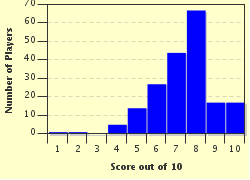Quiz Answer Key and Fun Facts
1. Which nursery rhyme is about a mouse running up and down a clock?
2. "As I Was Going to St. Ives" is another popular rhyme, but for other reasons than what you might think. It's also a riddle. There is a man who has many wives, who have many sacks, which hold many cats, who each have many kittens. How many of each were there?
3. "Little Jack Horner" is another popular rhyme, but it also has a very historical aspect to it. In this case, it is connected with men of very high power. Which of the following is highest in rank?
4. There's a very short rhyme called "Thirty Days Hath September" to remember the number of days in each month. How many months have EXACTLY 30 days?
5. There's a rhyme about a song of sixpence, but what was the grain in the pocket?
6. There's a rhyme about a man who was very nimble and quick, but I just can't remember his name. Do you remember it?
7. "Hey Diddle Diddle" is a short little rhyme, in which what eating utensil ran away with the dish?
8. "Ring a Ring o'Roses", also known as "Ring Around the Rosy", is a very popular children's rhyme with a dance to go along with it. What do the characters do in the end?
9. In what country did the rhyme "John Jacob Jingleheimer Schmidt" originate?
10. "London Bridge is Falling Down" is a common nursery rhyme, but there is another, less known version. Instead of falling, what has happened to the bridge?
Source: Author
SpaceGirl451
This quiz was reviewed by FunTrivia editor
looney_tunes before going online.
Any errors found in FunTrivia content are routinely corrected through our feedback system.


